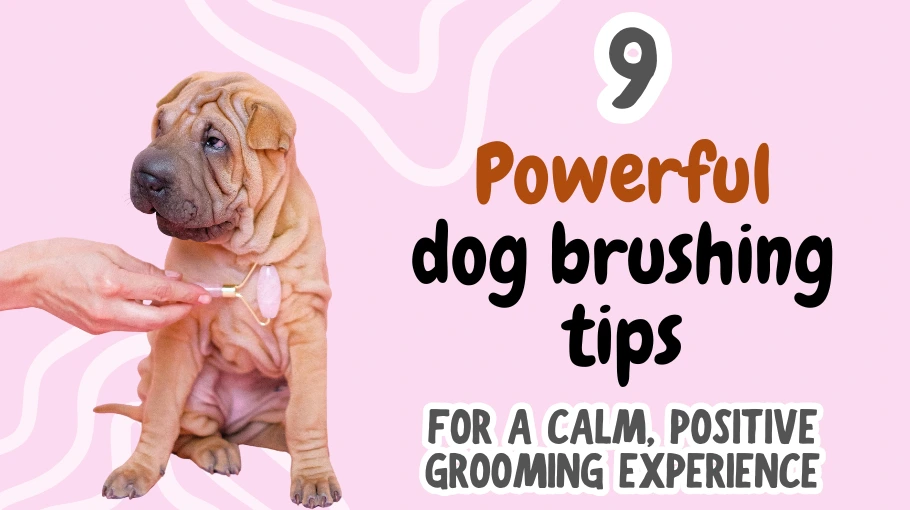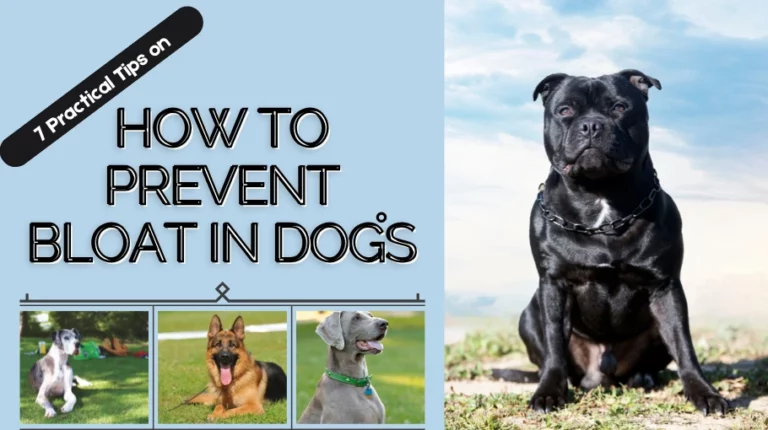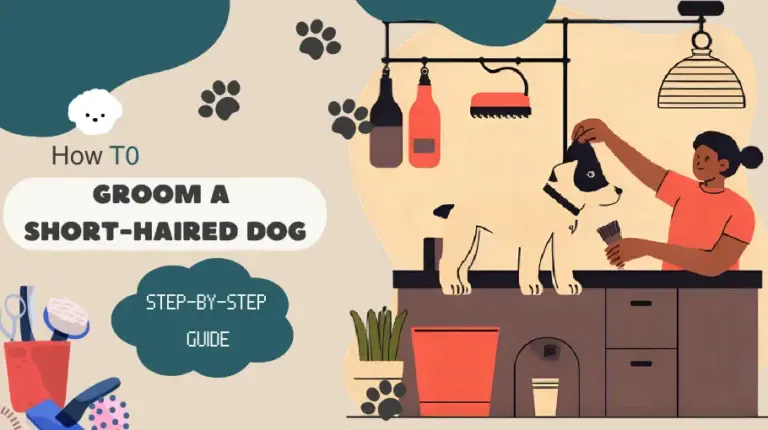9 Powerful Dog Brushing Tips for a Calm, Positive Grooming Experience

Before diving into the dog brushing tips, it’s important to know that puppy grooming is very different from brushing an adult dog. With puppies, you get a chance to shape their “normal” — touching teeth, brushing coats, bath time, and of course, socialising. We made the most of that early window.
Still, not everything went smoothly. One area I got wrong at first was the brush itself. I figured a brush was a brush — was I ever in for a rude awakening.
We’ve got two Staffies (brothers). One’s naturally nervous, the other takes everything in his stride. Back then, I wasn’t clued up on brush types or coat needs, so I grabbed what looked like a solid option. Turned out it was a slicker brush — and for our anxious Staffy, it was the worst choice I could’ve made.
Our thick-coated Staffy never flinched, but the thinner-coated, more nervous one? He bolted straight into his crate, his safe space when he’s spooked. It took some swapping between hand and rubber brush before he finally started seeing grooming as just another form of petting/bonding.
Whether you missed the chance to shape your dog’s experience as a pup, or you’re working with a rescue or older dog who needs some TLC, remember this: it’s never too late to make brushing a positive experience.
That’s exactly what the tips below are designed to help with.
Discover 9 Dog Brushing Tips for Nervous Dogs
1. Start with Desensitisation Training
If your dog is anxious around brushing, the key isn’t to force it — it’s to slowly desensitise them so the brush becomes just another part of a calm, positive routine.
With my two Staffies, we leaned heavily on the Quiet Time Training method we’d used when they were pups (guide here). For my more nervous boy, this became essential.
To link brushing with calmness, I recommend pairing it with relaxing music (see our music therapy guide) or after a stressful trigger like fireworks (fireworks coping tips here).
The trick is in the approach: don’t chase your dog with a brush. Keep it nearby but out of sight — tucked in a treat pouch or under a cushion — and wait for the right moment. When your dog is at their most relaxed (on their back, or lying with their head turned away — both signs of trust), you can gently introduce the brush.
At first, don’t even use it as a brush. Just make contact with a stroke or two, then praise like crazy: “Good boy! That’s it, attaboy.”
Start with areas they’re most comfortable with, like the back, before slowly moving toward more sensitive spots like the belly, legs, or tail. In the beginning, even a few gentle strokes to make contact is progress.
Dogs mirror our energy. If you’re tense, they’ll be tense. This aligns with research showing that dogs are highly attuned to human emotions. For example, a study published in Psychology Today discusses how dogs mirror our stress levels.
If you stay calm, confident, and positive, they’ll start to associate brushing with that same state of mind. Over time, this turns grooming from a trigger into anticipation.
2. Choose the Right Brush for the Coat
When it comes to short-haired breeds like Staffies, softer really is better. The best grooming brushes for short coats are either rubber brushes or natural boar bristle brushes. They’re gentle on sensitive skin and turn brushing into something closer to a massage than a scratch.
I learned this the hard way. Early on, I grabbed a slicker brush thinking “a brush is a brush.” That mistake made my thin-coated Staffy bolt for his crate — and to this day, he’ll still get wary if he sees the sight of a pin-and-bristle combo brush.
Meanwhile, his thicker-coated brother actually needs that combo brush occasionally (he loves rolling in wet grass and his coat can clump). But, to use it, the anxious one is best distracted with a toy in another room.
The bottom line? Match the brush to the coat, not the breed. If you’re unsure what suits your dog, this guide on how often to brush your dog also covers which brush types work best for different coats (single and double) — and which to avoid.
3. Keep Sessions Short and Positive
One of the best lessons I took from puppy training class (see: what to expect from dog socialisation classes) was this: even though the class lasted an hour, each interaction was only a few minutes at a time. Puppies — and dogs in general — learn best in short bursts.
Once they’re tired or overstimulated, frustration kicks in. I’ve seen it once too many times on countryside walks: after too many zoomies off-lead, my Staffies conveniently “forget” every command they’ve ever learned.
Brushing works the same way. For our anxious boy, it took several short sessions before he started to see the brush as part of normal life. These weren’t full-on grooming sessions, just a stroke or two with plenty of praise. That patience made all the difference.
What helped our anxious dog most was watching his brother roll onto his back with a big Staffy smile, clearly loving the belly rub–brushing combo. That kind of positive peer example reassured him more than anything — it showed him brushing wasn’t something to fear, because his brother was enjoying it.
The takeaway? Don’t push for long brushing sessions right away. Keep them short, calm, and positive, and build up slowly. Patience pays off.
4. Let Your Dog’s Personality Guide How You Help Them Relax
Every dog has their own way of self-soothing, and brushing goes much smoother when you work with that, rather than against it. Toys for play, treats for training, music for relaxing — that was our approach anyway.
Some dogs find comfort in familiar scents, like their blanket. Placing it on the floor while you sit beside them for petting, brushing, or bonding may help them feel safe.
With our anxious Staffy, licking is his go-to calming behaviour. We leaned into that: sometimes he had a lickimat with peanut butter, other times he just licked my hand or arm while I gently worked on his coat. His boisterous brother didn’t need that — he relaxed naturally and enjoyed the interaction without extra support.
Music also helped. From when they were pups, we used music therapy for dogs to create calm time. The dogs knew that when the music played, it was chilling out time.
The key is to observe and understand your dog’s cues. By tuning into what naturally helps them feel secure, you can turn grooming into a calm, positive experience tailored specifically to them.
5. Set the Atmosphere for a Calm Brushing Experience
Brushing goes best when your dog feels relaxed and the environment supports calm behaviour. Even a short 5-minute training session can be more mentally tiring than a 30-minute run around, so it’s important to manage their energy first.
Remove toys, put away high-value treats used in training, and make sure there are no distractions. Soft background music, white noise, or low-volume TV can help set a calming atmosphere.
You can also integrate brushing into other routines, like shower time. Using water with a rubber curry brush can make even muddy or smelly patches easier to clean — and the gentle touch, combined with the soothing scent of dog shampoo, often helps anxious dogs relax.
The key is to observe your dog and adjust: some dogs respond to touch first, some to scent, some to sound. By controlling the environment and keeping the experience predictable and positive, brushing becomes less of a chore and more of a bonding moment — even when you’re tackling the inevitable “rolled in who-knows-what” moments with a brush and shower head in hand.
6. Brush from Head to Tail
For routine grooming, the simplest and most comfortable method for your dog is to brush from head to tail. This follows the natural direction of the hair, preventing tugging or pulling that could make brushing painful or stressful.
The “back-brush” method — brushing against the hair — is usually only needed for long-haired dogs to untangle mats or prep the coat for clipping. For short-haired breeds, including thick-coated Staffies, it’s unnecessary for coat maintenance.
Using a head-to-tail technique keeps brushing gentle, effective, and predictable for your dog. Over time, they’ll learn that brushing is a calm, comfortable part of their routine rather than something to be anxious about.
7. Use Gentle Pressure and a Slow Rhythm
Dogs have extremely sensitive skin. Even a ‘soft’ brush can be too rough if you brush frantically. Groomers call it brush burn. Smooth motions with minimal pressure let the brush do the work, rather than relying on your arm strength.
This is especially important for long-haired or double-coated dogs. If you’re using a comb on a tangle, you want to feel the knot and gently pinch the fur as close to the skin as possible. The goal is to untangle or loosen mats, not pull hair out from the root.
Your dog’s reaction is your best indicator. Signs of discomfort — flinching, yelping, or pulling away (see how to spot pain in dogs) — mean you need to ease up.
A good way to gauge pressure is to try the brush on your own bare skin. Notice how different rhythms and pressure feel — friction becomes uncomfortable fast. Keep your strokes smooth and gentle, and brushing will be a positive, comfortable experience for your dog.
8. Let Your Dog’s Behaviour Guide Brushing Frequency
For short-haired breeds like Staffies, strict routines aren’t always necessary. Instead, watch your dog and let their behaviour guide you. Should they not be used to being brushed, you’ll find our short-hair dog grooming guide helpful to desensitise them, getting them used to being brushed, and washed.
With our Staffies, brushing about once a week works for them, but the real cue comes from their scratching or loose hair. When you notice more frequent or intense scratching, or clumps of hair coming off, it’s time to groom. This approach keeps brushing meaningful and responsive to your dog’s actual needs.
Brushing isn’t just about aesthetics — it helps distribute natural oils, removes dirt, dander, and potential irritants, and supports healthy skin. For dogs prone to allergies or sensitive skin, like many Staffies, regular attention to coat condition can prevent problems before they start.
By paying attention to your dog’s cues rather than sticking to a rigid schedule, grooming becomes a responsive, stress-free activity — something that keeps your dog comfortable and healthy, rather than just a chore on a calendar.
9. Seek Professional Help if Needed
Some dogs are simply more resistant to brushing than others. Anxiety, past negative experiences, or just strong-willed personalities can make grooming feel impossible at home. If that sounds familiar, don’t be discouraged — you’re not alone.
Professional dog groomers handle a wide range of temperaments every day, including dogs that absolutely hate being brushed. They have techniques, tools, and the experience to work through the early desensitisation phase safely and calmly.
Even one or two professional sessions can make a big difference, giving your dog a chance to associate brushing with something routine rather than stressful.
Think of it as extra support, not a failure. By leaning on a groomer’s expertise, you’re helping set your dog up for long-term success — and making future at-home grooming sessions far easier for both of you.






